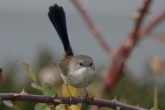You are here
Home ›More about Superb Fairy-wrens
The Superb Fairy-wren is the most widespread of the ten species of Fairy-wren, which are found only in Australia. Fairy-wrens are not closely related to the wrens of the northern hemisphere. The Superb Fairy-wren is found in south-eastern Australia, south from the Tropic of Capricorn through to the south-eastern corner of South Australia. It is an abundant species and was once common in urban areas, although it now appears to be disappearing from major cities.
Fairy-wren families
Superb Fairy-wren males defend a territory of between 0.5 and 2 ha, and there is some evidence from radio tracking that territories are smaller in urban areas. Fairy-wrens live in family groups, with the young of previous years remaining in their parents' territory and contributing to the care of their younger siblings. Males are more likely than females to stay with their parents, and so, during the breeding season, it is common to see a brown female accompanied by several blue males. During the non-breeding season, males moult into a brown plumage, similar to the female's, except that males retain their blue tails. The black beak of males is also a good way of distinguishing them from females and juveniles, which have a chestnut-coloured beak.
Unfaithful males
Fairy-wrens have been described as 'the least faithful birds in the world' because DNA fingerprinting has revealed that more than three quarters of the young within a 'family' group are sired by males from outside the group. Females prefer 'high-quality' males, and therefore only 4% of the males in an area sire 50 % of the offspring.
The attribute of male Superb Fairy-wrens most related to their attractiveness to females is the length of time they hold their bright blue breeding plumage. This is also related to the age of males: older males are more attractive than younger males. Two-year-old males moult into their breeding plumage in July, whereas one-year-old birds wait until September. Some top-quality, older, males moult directly from breeding plumage to breeding plumage, without going through the 'brown', non-breeding, stage. Males devote considerable energy to displaying to females: thirteen different males have been observed to display to a single female over a 30 minute period. Females do not copulate with males while they are displaying, but instead, fly into the territory of their preferred male just before dawn, while it is still dark.
Reference
Peters, A. 2002. The burden of beauty. Nature Australia 27(5): 30-37











